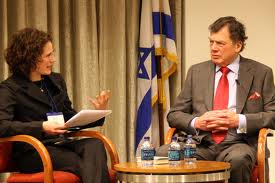Category Archives: Young Adults
“We must ask ourselves: which behaviors, skills, and dispositions are we hoping to cultivate among young Jews, and how might they best be imparted?”
“You can’t ignore the Internet…It’s where millennials are living their Judaism”
“Our dilemma today is that at the very time that we desperately need an ideological linkage between powerful Israel experiences and the creation of robust Jewish communities for young Jews in America, Zionism is absent from the mix”
“Take young Jews, 18-26, on a free trip to Israel and they will return rededicated to Jewish life, says the conventional wisdom. This model would have worked a generation ago”
“Like synagogues, the Jewish federation system…once defined community for North American Jews. … Today, however, Federation seems distant from the lives of most Jewish young people….”
This gallery contains 0 photos.
Like synagogues, the Jewish federation system (usually referred to simply as “Federation”) is another...“If we want real institutional change, all areas of the Jewish community should seek to foster young leadership”
…if we want real institutional change, all areas of the Jewish community should seek to foster young leadership. In every commencement speech, we hear youth described as our future. This is most certainly true, and, yet, Jewish organizations are loath to act on that dictum. The reason is obvious: No one wants to be usurped and declared redundant, so we hang on, in many cases, as long as possible, and keep the young aspirants for Jewish communal life at bay.
Edgar M. Bronfman and Beth Zasloff, Hope, Not Fear: A Path to Jewish Renaissance (New York: St. Martin’s Press, 2008), 177.
“Let’s redirect funds used for fighting anti-Semitism toward Jewish renaissance programs”
…let’s redirect funds used for fighting anti-Semitism toward Jewish renaissance programs. I have publicly stated that it is a waste of the Jewish tax dollar to spend so much money on so-called defense organizations. Anti-Semitism in this country is, for all practical purposes, dead. Yes, there are incidents, but we live in a racist world, and there will always be graffiti and random insults from deranged, sick people. They are a small minority.
Edgar M. Bronfman and Beth Zasloff, Hope, Not Fear: A Path to Jewish Renaissance (New York: St. Martin’s Press, 2008), 175.
“Traditional Jewish institutions must seek guidance from creative young leaders, and some have begun to do so…”
Traditional Jewish institutions must seek guidance from creative young leaders, and some have begun to do so. Young Jews are finding ways to be Jewish outside of traditional Jewish institutions, but that does not mean we have to battle for who controls Jewish life….
We need to cultivate this spirit of openness and exchange between new efforts and traditional Jewish institutions. Both are important for the renaissance. While there is exuberant energy outside the established Jewish community, there are tremendous financial, structural, and human resources in our large institutions. These resources can, and should, be used to educate and empower our youth. While change may happen more quickly in new efforts, existing organizations are capable of making a significant difference in Jewish life if they are willing to adapt to the conditions of the twenty-first century. They need to reach out to young people and invite their ideas and their leadership.
Edgar M. Bronfman and Beth Zasloff, Hope, Not Fear: A Path to Jewish Renaissance (New York: St. Martin’s Press, 2008), 167-168.
A “problem with the whole idea of “affiliated” and “unaffiliated” is that it depends on an outdated model for Jewish community…”
The problem with the whole idea of “affiliated” and “unaffiliated” is that it depends on an outdated model for Jewish community. The fact that young Jews are not affiliating in the old-fashioned way indicates there is something wrong with our institutions, not that there is something wrong with our youth. We have to let go of old ways of defining what it means to be an involved Jew and look to the kind of involvement that young Jews themselves seek. It takes some imagination to understand that the decline of Jewish institutions does not necessarily mean the decline of Judaism. Our question should not be “How can we get unaffiliated Jews to affiliate?” but “How can we inspire young Jews to understand Judaism as important for their own lives and for the world?” We should not be concerned with keeping Jewish institutions alive, but with keeping Judaism alive.
Simply because young Jews are not involved in the same way that their elders were does not mean that they are completely disengaged from Jewish life. While they may stay away from synagogues or Jewish Community Centers, they are clearly interested in Judaism. … They want to be Jewish, but on their own terms, as well they should.
Edgar M. Bronfman and Beth Zasloff, Hope, Not Fear: A Path to Jewish Renaissance (New York: St. Martin’s Press, 2008), 157-158.
